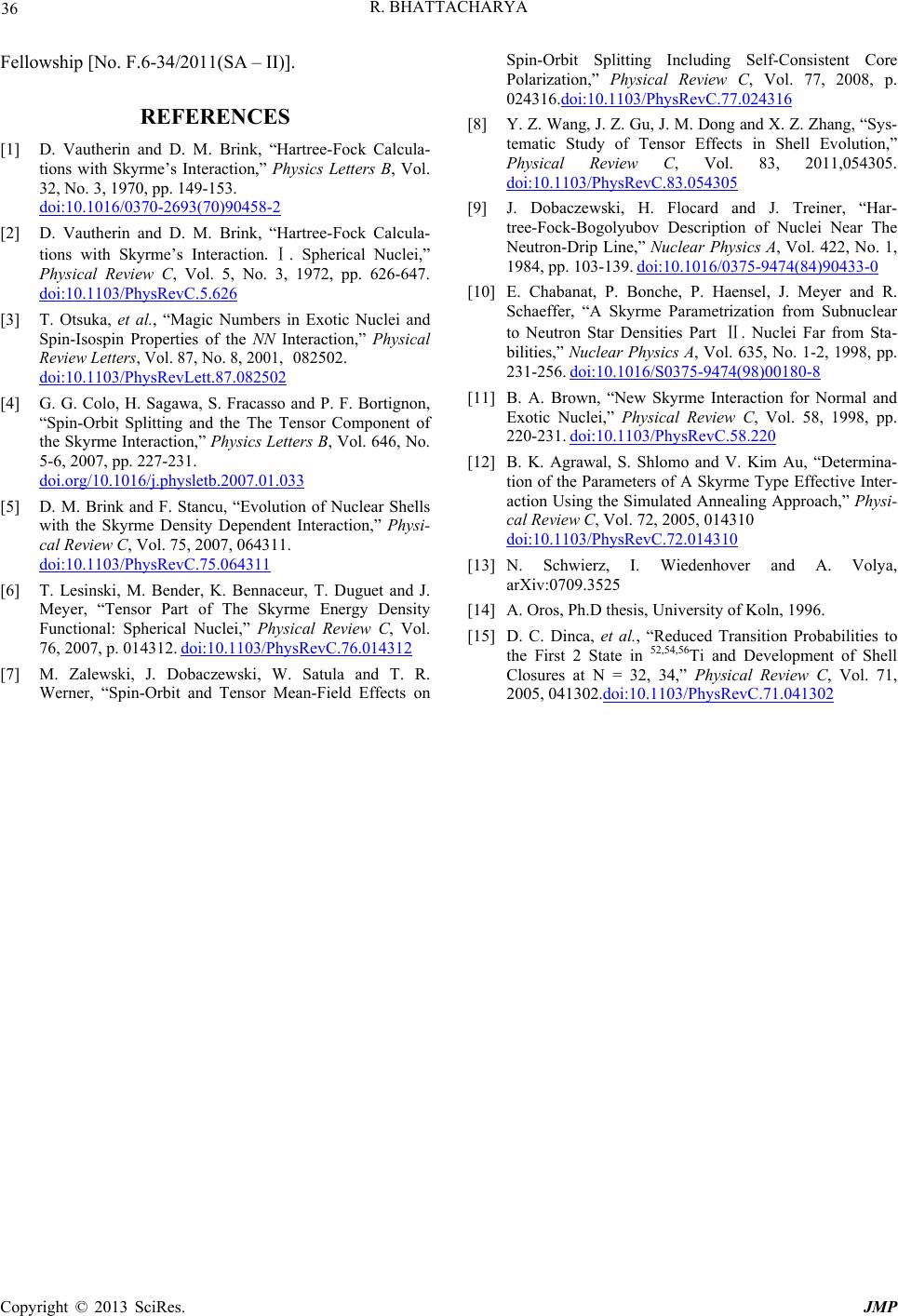
R. BHATTACHARYA
Copyright © 2013 SciRes. JMP
36
Fellowship [No. F.6-34/2011(SA – II)].
REFERENCES
[1] D. Vautherin and D. M. Brink, “Hartree-Fock Calcula-
tions with Skyrme’s Interaction,” Physics Letters B, Vol.
32, No. 3, 1970, pp. 149-153.
doi:10.1016/0370-2693(70)90458-2
[2] D. Vautherin and D. M. Brink, “Hartree-Fock Calcula-
tions with Skyrme’s Interaction.Ⅰ. Spherical Nuclei,”
Physical Review C, Vol. 5, No. 3, 1972, pp. 626-647.
doi:10.1103/PhysRevC.5.626
[3] T. Otsuka, et al., “Magic Numbers in Exotic Nuclei and
Spin-Isospin Properties of the NN Interaction,” Physical
Review Letters
, Vol. 87, No. 8, 2001,
082502.
doi:10.1103/PhysRevLett.87.082502
[4] G. G. Colo, H. Sagawa, S. Fracasso and P. F. Bortignon,
“Spin-Orbit Splitting and the The Tensor Component of
the Skyrme Interaction,” Physics Letters B, Vol. 646, No.
5-6, 2007, pp. 227-231.
doi.org/10.1016/j.physletb.2007.01.033
[5] D. M. Brink and F. Stancu, “Evolution of Nuclear Shells
with the Skyrme Density Dependent Interaction,” Physi-
cal Review C, Vol. 75, 2007, 064311.
doi:10.1103/PhysRevC.75.064311
[6] T. Lesinski, M. Bender, K. Bennaceur, T. Duguet and J.
Meyer, “Tensor Part of The Skyrme Energy Density
Functional: Spherical Nuclei,” Physical Review C, Vol.
76, 2007, p. 014312. doi:10.1103/PhysRevC.76.014312
[7] M. Zalewski, J. Dobaczewski, W. Satula and T. R.
Werner, “Spin-Orbit and Tensor Mean-Field Effects on
Spin-Orbit Splitting Including Self-Consistent Core
Polarization,” Physical Review C, Vol. 77, 2008, p.
024316.doi:10.1103/PhysRevC.77.024316
[8] Y. Z. Wang, J. Z. Gu, J. M. Dong and X. Z. Zhang, “Sys-
tematic Study of Tensor Effects in Shell Evolution,”
Physical Review C, Vol. 83, 2011,054305.
doi:10.1103/PhysRevC.83.054305
[9] J. Dobaczewski, H. Flocard and J. Treiner, “Har-
tree-Fock-Bogolyubov Description of Nuclei Near The
Neutron-Drip Line,” Nuclear Physics A, Vol. 422, No. 1,
1984, pp. 103-139. doi:10.1016/0375-9474(84)90433-0
[10] E. Chabanat, P. Bonche, P. Haensel, J. Meyer and R.
Schaeffer, “A Skyrme Parametrization from Subnuclear
to Neutron Star Densities Part Ⅱ. Nuclei Far from Sta-
bilities,” Nuclear Physics A, Vol. 635, No. 1-2, 1998, pp.
231-256. doi:10.1016/S0375-9474(98)00180-8
[11] B. A. Brown, “New Skyrme Interaction for Normal and
Exotic Nuclei,” Physical Review C, Vol. 58, 1998, pp.
220-231. doi:10.1103/PhysRevC.58.220
[12] B. K. Agrawal, S. Shlomo and V. Kim Au, “Determina-
tion of the Parameters of A Skyrme Type Effective Inter-
action Using the Simulated Annealing Approach,” Physi-
cal Review C, Vol. 72, 2005, 014310
doi:10.1103/PhysRevC.72.014310
[13] N. Schwierz, I. Wiedenhover and A. Volya,
arXiv:0709.3525
[14] A. Oros, Ph.D thesis, University of Koln, 1996.
[15] D. C. Dinca, et al., “Reduced Transition Probabilities to
the First 2 State in 52,54,56Ti and Development of Shell
Closures at N = 32, 34,” Physical Review C, Vol. 71,
2005, 041302.doi:10.1103/PhysRevC.71.041302